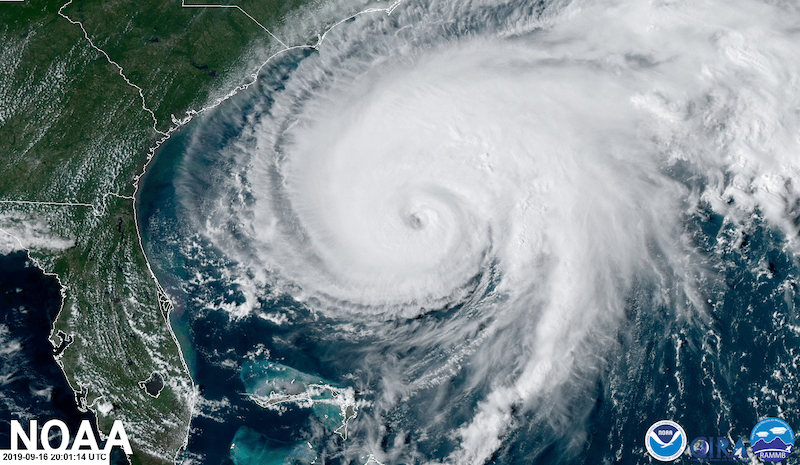
More intense storms ahead?
As global warming has progressed, you might have noticed more weird weather, including more intense storms. It appears certain now that climate change does affect localized tropical storms and thunderstorms. Scientists want to know exactly how that’s happening. And they want to know how these storms in turn affect their climate models. So, in November 2021, NASA announced it had selected a new Earth-science mission called INCUS. More about INCUS below. But first read on, to find out what two climate scientists said about the brighter lightning, higher winds, and increased rainfall we might expect as Earth’s climate continues to warm.

EarthSky 2022 lunar calendars now available! They make great gifts. Order now. Going fast!
Talking to the experts
EarthSky reached out to Ken Jucks, Program Manager for the Upper Atmosphere Research Program (UARP), and Gavin Schmidt, NASA’s new Senior Climate Adviser, with a few questions:
Are thunderstorms expected to increase in intensity or frequency due to global warming?
KJ: As the atmosphere warms and contains more water, convective storms are expected to increase, as there is more energy to drive the convective process.
What does “intensify” mean exactly?
KJ: Intensify means faster updrafts, higher updrafts, more mass within the updrafts, on average.
Will lightning be brighter and thunder louder?
GS: Lightning is driven by the strength of the convective updrafts so we expect it to increase with temperature. Also, as convective storms move poleward, we expect an increase in the range of lightning strikes, which can contribute to more wildfire ignition.
Will there be stronger winds?
KJ: With stronger convective storms, the winds in their vicinity will also increase.
Will there be more rain?
KJ: Around these convective storms, most likely, as there will be more water available to precipitate. Again, this is on average.
GS: There will be more rain on average, mostly in the equatorial region, and at higher latitudes. The overall pattern of rain will shift but this is still quite uncertain. More noticeable though will be the increase in rainfall intensity, like when it rains, it will rain harder. This is already detectable.

How storms affect climate models
So rainfall, winds and lightning are all expected to intensify. And that’s where INCUS comes in.
Take, for example, the way air and water vapor are transported up and down in storms. A scientist would speak of it in terms of convective mass flux (CMF). It’s a process that’s still not well understood. Scientists who study storms say that having CMF measurements over a full range of conditions would improve our knowledge of storm intensity. And it would also help them undertand cloud feedbacks, in which storms undergo change due to air temperatures at Earth’s surface. High cloud feedbacks can add uncertainty to climate and weather models.
To understand more about how such storms behave, the INCUS mission will study why convective storms, heavy precipitation and clouds occur exactly when and where they do. Correspondingly, the observations will also address the impact of storms on current models of climate change. Prior to this, the groundwork for these new studies came from the 2017 Earth Science Decadal Survey by the National Academies of Sciences, Engineering and Medicine.
By doing this, scientists can better understand how climate change is affecting these storms, both now and in the future. Moreover, this can help improve weather forecasting and the ability to predict extreme weather.

Karen St. Germain, NASA’s Earth Science division director, stated:
In a changing climate, more accurate information about how storms develop and intensify can help improve weather models and our ability to predict risk of extreme weather. This information not only deepens our scientific understanding about the changing Earth processes, but can help inform communities around the world.
A fleet of SmallSats
INCUS will consist of three SmallSat satellites flying in close formation. SmallSats are small spacecraft with a mass less than 397 pounds (180 kilograms) and about the size of a large kitchen fridge. The mission is scheduled to launch sometime in 2027 as part of NASA’s Earth Venture Program. INCUS will be an EVM-3 mission (Earth Venture Mission-3). The mission was selected out of 12 different proposals in March 2021. As Thomas Zurbuchen, associate administrator for NASA’s Science Mission Directorate, said:
Every one of our Earth science missions is carefully chosen to add to a robust portfolio of research about the planet we live on. INCUS fills an important niche to help us understand extreme weather and its impact on climate models, all of which serves to provide crucial information needed to mitigate weather and climate effects on our communities.
Broad support
INCUS has support from several NASA centers, including the Jet Propulsion Laboratory in Southern California, Goddard Space Flight Center in Greenbelt, Maryland and Marshall Space Flight Center in Huntsville, Alabama. The necessary satellite system components will be provided by Blue Canyon Technologies and Tendeg LLC in Colorado.
Overall, the cost of the mission is currently estimated to be $177 million. This does not, however, include the costs of the launch, and the launch provider has not yet been selected.
By the way, maybe you know that “incus” is a type of cloud, aka an anvil cloud. These sorts of clouds are associated with thunderstorms. But INCUS, in the case of the new NASA mission, stands for Investigation of Convective Updrafts. It’s clever because strong updrafts (and downdrafts) are such a key feature of thunderstorms.
Bottom line: NASA’s upcoming INCUS mission will investigate how thunderstorms and tropical storms affect climate models, and how climate change itself is affecting storms.
The post Intense storms from global warming, and a mission to study them first appeared on EarthSky.
from EarthSky https://ift.tt/3ocAJVI

More intense storms ahead?
As global warming has progressed, you might have noticed more weird weather, including more intense storms. It appears certain now that climate change does affect localized tropical storms and thunderstorms. Scientists want to know exactly how that’s happening. And they want to know how these storms in turn affect their climate models. So, in November 2021, NASA announced it had selected a new Earth-science mission called INCUS. More about INCUS below. But first read on, to find out what two climate scientists said about the brighter lightning, higher winds, and increased rainfall we might expect as Earth’s climate continues to warm.

EarthSky 2022 lunar calendars now available! They make great gifts. Order now. Going fast!
Talking to the experts
EarthSky reached out to Ken Jucks, Program Manager for the Upper Atmosphere Research Program (UARP), and Gavin Schmidt, NASA’s new Senior Climate Adviser, with a few questions:
Are thunderstorms expected to increase in intensity or frequency due to global warming?
KJ: As the atmosphere warms and contains more water, convective storms are expected to increase, as there is more energy to drive the convective process.
What does “intensify” mean exactly?
KJ: Intensify means faster updrafts, higher updrafts, more mass within the updrafts, on average.
Will lightning be brighter and thunder louder?
GS: Lightning is driven by the strength of the convective updrafts so we expect it to increase with temperature. Also, as convective storms move poleward, we expect an increase in the range of lightning strikes, which can contribute to more wildfire ignition.
Will there be stronger winds?
KJ: With stronger convective storms, the winds in their vicinity will also increase.
Will there be more rain?
KJ: Around these convective storms, most likely, as there will be more water available to precipitate. Again, this is on average.
GS: There will be more rain on average, mostly in the equatorial region, and at higher latitudes. The overall pattern of rain will shift but this is still quite uncertain. More noticeable though will be the increase in rainfall intensity, like when it rains, it will rain harder. This is already detectable.

How storms affect climate models
So rainfall, winds and lightning are all expected to intensify. And that’s where INCUS comes in.
Take, for example, the way air and water vapor are transported up and down in storms. A scientist would speak of it in terms of convective mass flux (CMF). It’s a process that’s still not well understood. Scientists who study storms say that having CMF measurements over a full range of conditions would improve our knowledge of storm intensity. And it would also help them undertand cloud feedbacks, in which storms undergo change due to air temperatures at Earth’s surface. High cloud feedbacks can add uncertainty to climate and weather models.
To understand more about how such storms behave, the INCUS mission will study why convective storms, heavy precipitation and clouds occur exactly when and where they do. Correspondingly, the observations will also address the impact of storms on current models of climate change. Prior to this, the groundwork for these new studies came from the 2017 Earth Science Decadal Survey by the National Academies of Sciences, Engineering and Medicine.
By doing this, scientists can better understand how climate change is affecting these storms, both now and in the future. Moreover, this can help improve weather forecasting and the ability to predict extreme weather.

Karen St. Germain, NASA’s Earth Science division director, stated:
In a changing climate, more accurate information about how storms develop and intensify can help improve weather models and our ability to predict risk of extreme weather. This information not only deepens our scientific understanding about the changing Earth processes, but can help inform communities around the world.
A fleet of SmallSats
INCUS will consist of three SmallSat satellites flying in close formation. SmallSats are small spacecraft with a mass less than 397 pounds (180 kilograms) and about the size of a large kitchen fridge. The mission is scheduled to launch sometime in 2027 as part of NASA’s Earth Venture Program. INCUS will be an EVM-3 mission (Earth Venture Mission-3). The mission was selected out of 12 different proposals in March 2021. As Thomas Zurbuchen, associate administrator for NASA’s Science Mission Directorate, said:
Every one of our Earth science missions is carefully chosen to add to a robust portfolio of research about the planet we live on. INCUS fills an important niche to help us understand extreme weather and its impact on climate models, all of which serves to provide crucial information needed to mitigate weather and climate effects on our communities.
Broad support
INCUS has support from several NASA centers, including the Jet Propulsion Laboratory in Southern California, Goddard Space Flight Center in Greenbelt, Maryland and Marshall Space Flight Center in Huntsville, Alabama. The necessary satellite system components will be provided by Blue Canyon Technologies and Tendeg LLC in Colorado.
Overall, the cost of the mission is currently estimated to be $177 million. This does not, however, include the costs of the launch, and the launch provider has not yet been selected.
By the way, maybe you know that “incus” is a type of cloud, aka an anvil cloud. These sorts of clouds are associated with thunderstorms. But INCUS, in the case of the new NASA mission, stands for Investigation of Convective Updrafts. It’s clever because strong updrafts (and downdrafts) are such a key feature of thunderstorms.
Bottom line: NASA’s upcoming INCUS mission will investigate how thunderstorms and tropical storms affect climate models, and how climate change itself is affecting storms.
The post Intense storms from global warming, and a mission to study them first appeared on EarthSky.
from EarthSky https://ift.tt/3ocAJVI

Aucun commentaire:
Enregistrer un commentaire